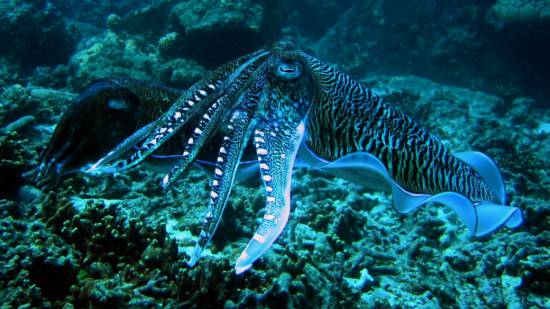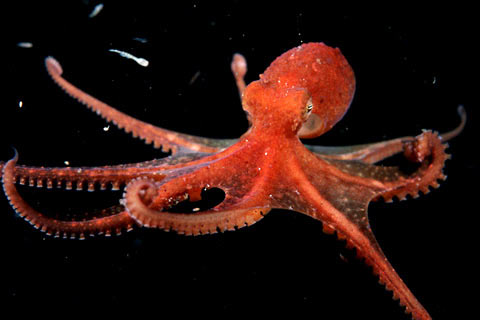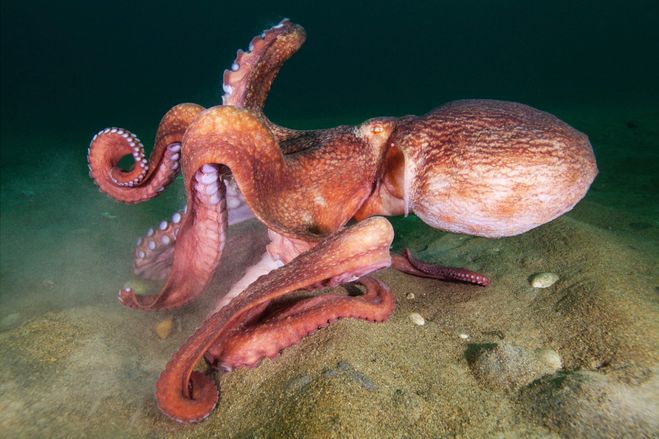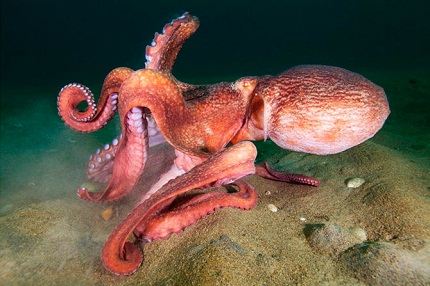26.07.2019
An animal similar to an octopus. The largest octopus in the world
In order to meet amazing aliens from other worlds who have a certain mind and are as different from humans as possible, you do not need to fly into space. They live next to us in the seas and oceans. These creatures - octopuses - a legacy of ancient times, images of huge octopuses, monsters from sea depths which people have always feared. They have long been credited with demonic glory and power, as if they are able to sink a ship or approach a diver with an insidious purpose in order to squeeze the victim with their tentacles and hold it until it suffocates.
Mysterious inhabitants of the water world
Modern researchers have long refuted all such legends and fantasies. The truth turned out to be impressive, these animals are endowed with a lot of amazing qualities:
- they are smart and sensitive (millions of tentacle neurons give them an unrivaled sense of touch);
- have excellent eyesight and are able to quickly analyze what they see;
- they have a well-developed nervous system;
- they have three hearts;
- their blood is blue;
- they have eight tenacious, constantly moving tentacles with suckers responsible for touch and balance, which are sometimes used as legs to move along the seabed;
- they communicate through color, while they themselves distinguish only black and white colors;
- move with the help of a jet engine;
- capable of perfect disguise and camouflage, changing the color of their skin and its texture in a split second.
These bizarre creatures do not have a skeleton or shell, they only have a soft elastic body that can change shape. Even the most big octopus will be able to squeeze into any gap that does not limit his only solid organ, his mouth-beak. This organ is made of keratin, like our nails, and looks like a parrot's beak. An animal weighing 16-18 kg can easily get into a hole with a diameter of 3.5 cm.
These inhabitants of the deep sea are terrible and charming at the same time, they carry away into the mysterious depths so that a person realizes all their charm and gets to know them better. There are more than 300 species of octopuses in the world, 100 of which are described, they have all kinds of shapes, colors and sizes. They can live in almost any habitat, from shallow coastal waters to deep hydrothermal vents. Of particular interest are large animals. This is an ordinary octopus, Doflein and Appolion.
There are stories about rare leviathans raised from the depths of the sea, whose weight exceeded 50 kg. Stories about scary giants with tentacles over 10 m in length appeared more than 50 years ago, and some individuals caught giant octopuses weighed over 180 kg, as much as a black bear weighs. This species has a bad reputation. Above the eyes of the octopus are two outgrowths resembling horns, for which he was nicknamed " sea devil". This is Doflein's octopus.
This type of cephalopod is the most studied. Such individuals live in the seas Far East off the coast of Japan and America. They prefer to live at shallow depths, not going below 300 m. Animals of this species are able to reach a weight of more than 50 kg, although their usual standard weight is 25 kg. There is a known case when an octopus was caught over 270 kg with a "span" of tentacles over 9 m.
At birth, Doflein octopuses are only 6 mm long and weigh 0.003 grams. They double their weight every three months. At the age of two years, they reach a weight of 2 kg, then up to 32 months they make a breakthrough, sharply increasing to 18 kg. These large octopuses feed continuously and eat all the food they can find, they can eat their own kind. These octopuses live only 4 years.
This predator lives in all tropical and subtropical oceans and seas, in shallow waters up to 150 m with rocky bottom areas. Standard body length - 25 cm, weight - up to 10 kg.

The common octopus lives alone, hiding from big fish And marine mammals, disguised only when he chooses to hunt. Life expectancy - no more than two years.
Apollyon
This view is huge. An octopus can claim to be a giant. But Apollyon has only one drawback - its little weight at large sizes body. The proportions of an octopus of this species resemble a non-standard spider: long, fragile and thin legs extend from a small body.
Apollyons live in the rocks off the coast of western Canada, Alaska and California. The deep, cold, oxygen-rich waters provide optimal living conditions for maximum octopus growth.
The modern context of the image of an octopus is the image of a graceful giant, however, it has been noticed that over the past 15-20 years, large octopuses weighing 50 kg have become less and less common. This may be a genetic trait that gives octopuses a smaller size than they did 50-80 years ago. The reasons may be substances that pollute the oceans, and increased fishing for food of octopuses (crabs). Or maybe in a warming world, these sensitive giants just lay low? Climate change is definitely a threat to huge octopuses. It is possible that supergiants exist at depths that humans cannot yet descend using modern equipment.
For many centuries, the minds of sailors were excited by a possible meeting with giant kraken- a monster, the size of a small island, which drags careless ships into the depths of the sea with its tentacles. whether there is the largest octopus in the world or real prototypes this monster does not differ in impressive dimensions.
Top 4 largest octopus species
Cephalopods are characterized by a predatory disposition, but more often become victims of humans and more large inhabitants ocean, including sperm whales and killer whales. There are about 200 species of octopuses. Most of them are small benthic animals. Giants are worth looking for among the pelagic species plowing the depths of the oceans.
4. The long-tentacled octopus lives in Mediterranean waters. It was first described in 1826. The bright red body of the animal is covered with luminous white spots. Leads night image life by hunting fish and smaller octopuses. The octopus does not refuse crustaceans and bivalves. From spring to late summer, the female long-tentacled octopus mates, and then makes a single clutch. The octopus guards future cubs until the appearance of 4 mm fully formed babies. Shortly thereafter, the mother octopus dies of exhaustion. The mantle extends 15 cm, but the tentacles lengthen the total length of the octopus body up to 1 m. An adult weighs cephalopod 400

3. The common octopus is the most common species of this order in the world. He lives in the Mediterranean and Atlantic Ocean. The brain is well developed. Able to change color depending on the situation, but the usual color is brown. Feeds on plankton, fish, mollusks, crustaceans. Females take care of the clutch and do not leave the nest for half a year, which is necessary for the cubs to develop in the egg. It is of commercial interest to humans and is mined as food product. The body length usually reaches 25 cm, and the tentacles - 90 cm. However, specimens with limbs up to 130 cm come across, which gives the total length of the creature about 170 cm.

2. The Doflein Octopus, sometimes called the Giant Octopus, is common in northern coastal waters. Pacific Ocean. Arranges a lair on rocky ground: in underwater caves and secluded crevices. The Japanese and Koreans catch them as a game animal. The average representative grows up to 2 - 3 m with a weight of 25 - 50 kg. There is evidence of the existence of specimens up to 9.6 m in length. It is he who holds the title of the largest cephalopod in the world, according to the 2015 Guinness Book of Records.
1. The seven-armed octopus received such a strange name not at all because it is disabled without one limb. The hectocotylus of this species is folded into a pouch under the right eye. This is the modified eighth tentacle hidden from view, which the octopus uses to fertilize the female. In length, these creatures grow up to 3.5 m, and weights reach up to 75 kg.

Largest Known Octopus Specimens
The legends of the notorious krakens did not come from sailors' susceptibility alone. Sometimes the ocean waves washed ashore the corpses of the monstrous inhabitants of the depths. How big can individual members of the octopus order be?
- In 1945, a specimen up to 8 m long and weighing 180 kg was caught off the coast of the United States.
- Once, a Doflein octopus with 9-meter tentacles and a mass of more than 270 kg was caught in the net.
- Off the coast of Tasmania, a representative of the octopus order, 3.7 m long and almost a meter across, was caught. In the stomach of an octopus, fishermen found a piece of T-shirt from the previously missing crayfish hunter Shaw Burke. It is not known whether the clothes ended up inside the animal by accident or if it attached a tentacle to the death of a person. And so the legends about the kraken are born.
In the last 20 years, octopuses weighing about 50 kg come across much less frequently. Maybe, smart creatures decided that large size is not such a profitable evolutionary acquisition. major representatives sperm whales and killer whales are easily noticed, people catch them for food. It is easier for small octopuses to hide in secluded gorges from dangerous predators. The giants of the eight-armed clam world are a thing of the past.
On this moment the largest and heaviest octopus in the world – this is a representative of either seven-armed or doflane. However, in the future, they are also crushed, giving way to other giants of the deep sea. of this detachment served as the basis for the myths about the legendary kraken - a monster that drags entire ships into the depths of the sea. Jules Verne dedicated an entire scene to him in the immortal Twenty Thousand Leagues Under the Sea. Even if large octopuses cease to fall into the nets of fishermen and divers' cameras, the legend about them will not cease to live in the minds of dreamers.
The most famous representatives of cephalopods are octopuses. They are quite different unusual appearance- a short and soft body ends with tentacles, nature has not deprived them. There are eight of them. And they all play the role of "hands", which are interconnected by membranes, and on the surface of which there is one row or more suckers. There may be about two thousand of them in general. And each can withstand up to one hundred grams of weight.
Blue blood
This cephalopod breathes with gills, but despite this, the octopus can do without water for quite some time. Another feature of the animal can be considered the presence of not one, but three hearts at once. One organ drives blue blood through the body, while the other two push it through the gills.
Blue-ringed octopuses are found off the western shores of the Pacific Ocean. They are the most dangerous creatures in the world. Their venom is extremely toxic.
Extraordinarily smart
Interesting fact: octopuses are quite intelligent animals. In terms of development, they can be compared with dogs and cats. These cephalopods are able to change the color of their coloration, and quite quickly, literally in one second. And this is thanks to the skin cells that are filled with the pigment of the most different colors. Special muscles pull the cells, the color pigment begins to spread and occupy a huge area. Therefore, the shade of the body changes.
The smallest octopus is only four centimeters long. But scientists argue about the size of the largest and still cannot give an exact answer. They say that once they caught a representative of the species of cephalopods, in which the span of tentacles reached 9.6 meters. The weight of the giant was exactly 272 kilograms. However, there is no confirmation of this fact.
The biggest octopus
Doflein's giant octopus is called the giant octopus for a reason. The size of his head is approximately 60 centimeters. The tentacles have a span of more than three meters. The maximum weight of the animal is about 60 kilograms. And these are already proven and proven truths.
Doflein's octopus lives in the North Pacific Ocean. The animal prefers quite low temperatures. It is more comfortable for him to live if the water warms up to a maximum of 5-12 degrees above zero. Expanse is provided to them on the surface and at a shallow depth. Therefore, Doflein's octopus can often be seen by tourists with scuba gear. And, as a rule, flocks of giant octopuses are found. And in most cases, for an animal, the meeting ends in failure - it is caught and, usually, eaten. And only after that, lovers of exotic dishes wonder why the octopus has a rubbery taste. The answer, by the way, is simple - you need to be able to cook it.
And a little more about the habitat, the octopus prefers rocky soils. The animal hides in caves, in crevices and among boulders. In summer, the giant octopus lives in all types of soils. Often a cephalopod can be found on the border of sandy and rocky soils, near steep capes. It is almost impossible to stumble upon it in the center of deep bays in pebbly and sandy soils. And in open areas, the octopus digs wide holes with its tentacles and uses them as its lair.

As for Doflein's appearance, scientists say it's hard to believe that the octopus has blue blood. It turns out an aristocrat from the depths of the sea, but with a rather original appearance. Nature created him different from others, a kind of bag with tentacles and eyes. The length of the body of an octopus from the rear end of the body to the middle of the eyes (this is the standard measurement of the animal) is 60 centimeters. And the total length is about 3-4 meters. The weight of the cephalopod is up to 55 kilograms. The largest specimen, which was measured and entered into the Guinness Book of Records, had a length of tentacles, excluding the body, exactly 3.5 meters. Its weight was 58 kilograms.
jet powered animal
On each of the eight tentacles of a giant octopus, there are two rows of suckers, 250-300 on each foot. The membrane between the tentacles is not deep, but can be greatly stretched, and in this form is so thin that it is almost transparent. If you manage to shoot an animal hovering in the water with a camera against the sun, then you get a very effective picture. From the bottom of the head, the octopus has a tube called the rostrum. This is a kind of jet engine that serves as a means of transportation. Few creatures in the world have such a "device". To swim, the octopus draws water into the mantle, then contracts the mantle muscles and abruptly throws the water out through the funnel. By the way, the octopus swims backwards, the tentacles are behind the body. In water flight, the two outermost tentacles with stretched membranes are used as wings, while the rest serve as a fuselage, as in an airplane. And through the rostrum, at the same time, a “smoke screen” is placed, that is, ink is ejected, but this is when frightened.
All about octopuses
But the mouth of an octopus is in the center of the ring of paws. And in the mouth there is a beak, which is very similar to the beak of a parrot. However, lower jaw slightly goes beyond the top, and not vice versa. In adult giant octopuses, the beak is usually dark brown in color, while in young it is transparent. Therefore, the darkening of the beak is a kind of sign of puberty. There is a horn grater on the tongue of the animal (this is a radula). She has many transverse rows of small cloves - seven in each row. The central row is the sharpest and largest, it acts as a rotary drill. With it, the octopus drills through the shells of crabs and shells of shells. Usually the color of the animal is red-brown with a mesh pattern on the body and light stains. But a giant cephalopod can instantly change its color from white to dark purple.
As a rule, in summer and autumn, the octopus makes seasonal migrations. On the eve of spawning, the animal moves to shallow depths and lives with its relatives, that is, clusters. And in autumn, after spawning, octopuses disperse throughout their habitat for several days, live outside the clusters and inhabit the rocky ground.


